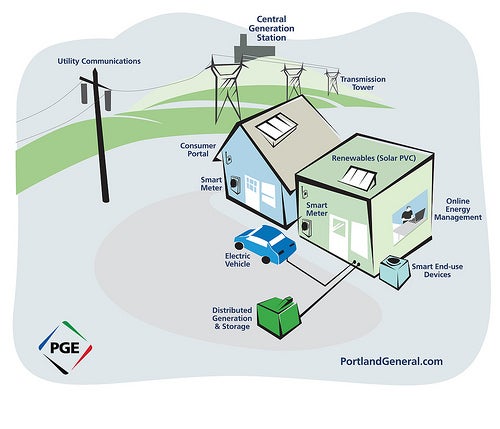Resiliency+: Smart Grid Technologies and the Benefits of Two-Way Communication
 It’s September, fall is around the corner, and with it, the second anniversary of devastating Hurricane Sandy. A smarter, more efficient electric grid should be on the minds of all New Jerseyans. Unfortunately, it’s not.
It’s September, fall is around the corner, and with it, the second anniversary of devastating Hurricane Sandy. A smarter, more efficient electric grid should be on the minds of all New Jerseyans. Unfortunately, it’s not.
Wired magazine calls America’s power grid the largest machine ever built. Over the past few decades, this grid has been expanded throughout the country to ensure that even remote areas have electricity. Although this is an incredible accomplishment, the grid should also strive to keep pace with the latest technological advances, becoming not just the largest machine ever built, but also a more efficient and resilient one.
What is the smart grid?
The electric grid of the future is called a smart grid. In reality, a smart grid isn’t any particular gadget, but a portfolio of products and grid improvements that can enable a more efficient, responsive, resilient, and clean electricity system. Technologies that improve consumer options, integrate clean energy resources, support electric vehicles, or improve energy efficiency are all considered part of a smart grid. We’ve covered some of these technologies earlier in this series, such as renewable energy, microgrids, and energy storage.
A smart grid could, for example, come equipped with such technologies as volt/VAR technology, which reduces the amount of electricity wasted in transporting electricity, or FLISR (Fault Location, Isolation, and Service Restoration) technology, which locates faults on the distribution system.
Smart meters are another key example of a product that is often included in a smart grid. These meters boost efficiency and lower costs by allowing for two-way communication between a utility company and its customers. Historically, meters have only allowed utilities to see how much energy a customer has used over any given time frame. With a smart meter, customers can see how much electricity they are using on a real-time basis instead of having to wait until the end of the month. As a result, customers may opt to reduce electricity use during peak periods when it is more expensive. By voluntarily reducing their electricity demand, customers save money and put less pressure on the central power grid, relieving the utility of having to invest in additional power substations. By the end of 2012, smart meters covered one third of the country, with installations expected to expand by more than 50 percent next year.
New Jersey and the smart grid
A smart grid would have been particularly helpful during Hurricane Sandy, which knocked out power for a third of homes and businesses in New Jersey for days, weeks, and in some cases, months. Smart meters and FLISR technology help utility companies identify power outages immediately. Smart meters send out a ‘last gasp’ call, which utilities use to identify both the location and extent of the outage, leading to better planning and quicker response times. For example, the utility Pepco, which operates in Maryland and Washington D.C., used its smart meters to identify power outages, helping to restore power for 95 percent of customers within 48 hours.
New Jersey, like most states, is making progress in implementing some types of smart grid technology but not others. Public Service Electric & Gas, the state’s largest utility, recently got the green light from regulators as part of its Energy Strong settlement to begin upgrading its system with FLISR technology, and a distribution management system that would improve electricity data transfer. However, the utility has had to put plans to install smart meters on hold in parts of its service territory as regulators evaluate the costs and effectiveness of the technology.
To improve resiliency, New Jersey should continue investing in smart grid technologies that will help the state more effectively respond to natural disasters, while at the same time supporting a cleaner, more interactive electricity grid. Only through these improvements can the ‘largest machine’ become a more efficient one as well.
Resiliency+ is a blog series, which highlights the ways in which different clean energy resources and technologies can play an important part in increasing energy resiliency in New Jersey and around the country. Check back every two weeks, or sign up to receive Energy Exchange blog posts via email.











One Comment
Very interesting article, I agree. In fact we are developing a european project called smart rural grid ( http://www.smartruralgrid.eu ) that the resilience plus smartmetering, will be the target trying to bring more quality at the electrical rural customers becouse we believe that it can not speak the smartgrid without smart rural grid.
Regards,
Ramon Gallart